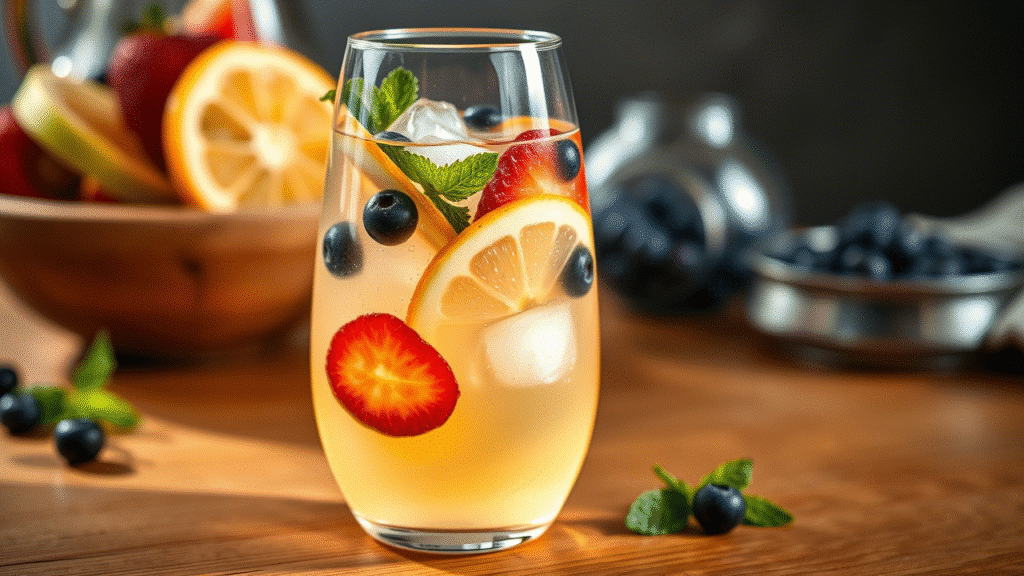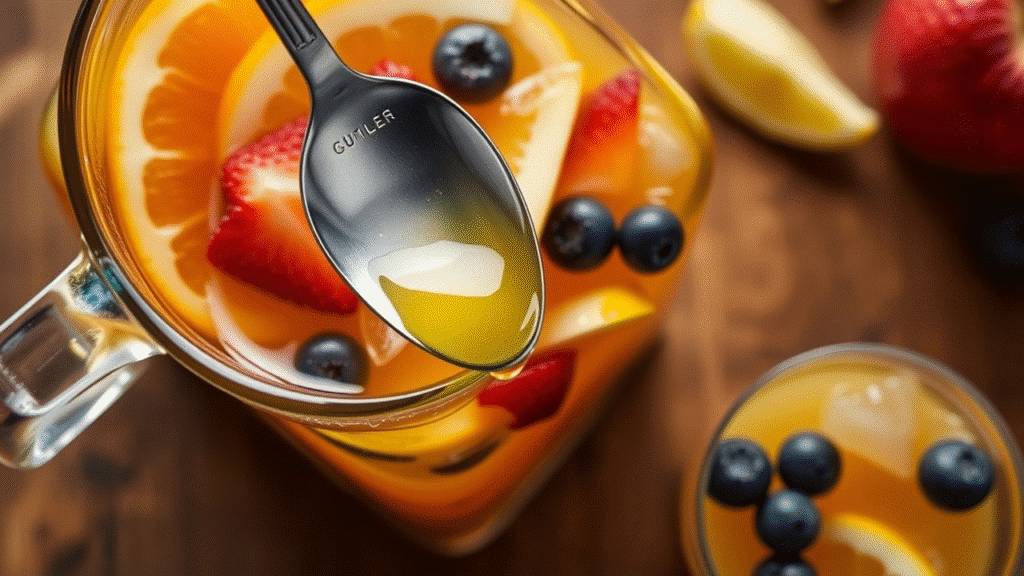The moment I watched a Spanish bartender in Barcelona carefully slice white peaches into paper-thin crescents for his sangria blanca, I knew I’d been making this drink all wrong for years. He moved with the precision of a sushi chef, explaining that each fruit piece needed to release just enough juice to flavor the wine without overwhelming it’s delicate character. That afternoon changed everything I thought I knew about white sangria.
White Sangria Delight isn’t just red sangria’s pale cousin – it’s an entirely different philosophy of drink making. Where traditional red sangria relies on bold, robust flavors that can stand up to heavy red wines, white sangria celebrates subtlety and elegance. The technique requires understanding how different fruits interact with white wine’s acidity and how to balance sweetness without masking the wine’s inherent characteristics.
This particular recipe elevates the concept by incorporating a sophisticated layering technique that creates visual drama while developing complex flavors over time. We’re using a combination of stone fruits, citrus, and berries that complement rather than compete with each other, along with a secret ingredient that most home bartenders never consider: a splash of high-quality elderflower liqueur that bridges the gap between fruit and wine.
The result is a pitcher drink that’s refined enough for elegant dinner parties yet approachable enough for casual summer gatherings. The key lies in understanding the science behind maceration and how different fruits release their flavors at different rates.
Ingredients & Substitutions

For the Wine Base:
- 1 bottle (750ml) crisp white wine (Sauvignon Blanc, Pinot Grigio, or Albariño)
- 1/2 cup elderflower liqueur (St-Germain preferred)
- 1/4 cup brandy or cognac
- 2 tablespoons fresh lime juice
- 2 tablespoons agave nectar or honey
For the Fruit Medley:
- 2 white peaches, thinly sliced with skin on
- 1 cup green grapes, halved lengthwise
- 1 cup fresh strawberries, hulled and quartered
- 1 large Granny Smith apple, cored and diced small
- 1 lime, sliced into thin wheels
- 1 lemon, sliced into thin wheels
- 1/2 cup fresh mint leaves, gently bruised
For Finishing and Service:
- 2 cups sparkling water or club soda
- Ice cubes made from white wine (optional but impressive)
- Additional mint sprigs for garnish
- Edible flowers for elegant presentation (optional)
The wine selection forms the foundation of exceptional white sangria. Sauvignon Blanc provides crisp acidity and herbaceous notes that complement fruit beautifully, while Pinot Grigio offers clean minerality that won’t compete with delicate flavors. Albariño, if you can find it, brings stone fruit notes that create harmony with the peaches. Avoid oaked wines like Chardonnay, which can become muddy when mixed with fruit.
Elderflower liqueur is the secret weapon that separates professional-quality white sangria from amateur attempts. St-Germain is worth the investment for its refined floral complexity, but other elderflower liqueurs work if that’s unavailable. The liqueur adds depth and sophistication while bridging the flavor gap between wine and fruit. If you can’t find elderflower liqueur, substitute with 1/4 cup white vermouth plus 1 tablespoon simple syrup.
Brandy or cognac provides backbone and prevents the sangria from becoming too light or thin. Use a mid-shelf brandy – you don’t need top-shelf cognac, but avoid bottom-shelf spirits that can add harsh notes. Spanish brandy is traditional and works beautifully, but any decent brandy will do.
Fresh fruit quality makes or breaks this recipe. Peaches should be ripe but still firm, with fragrant skin that yields slightly to pressure. Overripe peaches become mushy and cloud the sangria. If good peaches aren’t available, substitute with firm pears or even Asian pears for different but delicious results.
The apple choice matters more than most people realize. Granny Smith provides tartness that balances the sweetness while maintaining texture even after hours of maceration. Avoid soft apples like Red Delicious that turn mealy quickly. Honeycrisp or Fuji work well as alternatives if you prefer slightly sweeter flavor.
Step-by-Step Instructions
Preparing the Fruit Components
Begin your preparation at least 4 hours before serving, though overnight maceration produces superior results. Start with the peaches, which require the most careful handling. Wash them thoroughly but leave the skin on – it adds color, flavor, and prevents the flesh from breaking down too quickly.
Slice the peaches into thin crescents, removing any bruised sections. The key is uniform thickness – about 1/8 inch thick allows proper flavor extraction without creating mushy pieces. Place the sliced peaches in your serving pitcher immediately to prevent browning.
Cut the grapes in half lengthwise rather than leaving them whole. This exposes more surface area for flavor release while maintaining structural integrity. Whole grapes often burst unexpectedly and can make the sangria too sweet in spots. Add the halved grapes to the pitcher with the peaches.
Creating the Flavor Base
In a separate bowl, gently muddle the mint leaves with the back of a wooden spoon. You want to bruise them just enough to release their oils without shredding the leaves completely. Over-muddling creates bitter notes from the chlorophyll. Add the bruised mint to your pitcher.
Combine the elderflower liqueur, brandy, lime juice, and agave nectar in a small bowl, whisking until the agave dissolves completely. This pre-mixing ensures even distribution and prevents the agave from settling at the bottom of the pitcher. Pour this mixture over the fruit and mint.
Wine Integration and Maceration
Pour the white wine slowly over the fruit mixture, stirring gently with a long wooden spoon to combine without bruising the fruit. The wine should just cover all the fruit – if it doesn’t, add a splash more wine rather than water.
Cover the pitcher tightly and refrigerate for at least 4 hours, but preferably overnight. During this time, the fruit releases its juices while the alcohol extracts flavors and preserves the fruit’s texture. Stir gently once or twice during maceration to ensure even flavor distribution.
Final Assembly and Service
About 30 minutes before serving, add the strawberries and citrus wheels to the pitcher. These fruits release flavor quickly and can become bitter if macerated too long. The timing is crucial – you want their bright notes without the harsh oils from citrus peels.
Just before serving, add the diced apple and pour in the sparkling water slowly to preserve carbonation. The apple’s tartness provides last-minute brightness while the sparkling water adds effervescence that lifts all the flavors. Stir once very gently to incorporate.
Professional Presentation Tips
Serve immediately in wine glasses filled with ice. If you’ve made wine ice cubes, use those instead of regular ice to prevent dilution. Garnish each glass with a sprig of fresh mint and, for special occasions, an edible flower or two.
The visual presentation should showcase the beautiful fruit pieces while the aromatics from the mint and elderflower create an enticing bouquet that greets guests before they even taste the drink.
Cooking Techniques & Science
The success of white sangria relies on understanding osmosis and alcohol extraction. When fruit is combined with wine and spirits, the alcohol draws out water-soluble compounds while the fruit’s natural acids interact with the wine’s existing acidity. This creates a complex flavor profile that’s greater than the sum of its parts.
Maceration timing is critical because different fruits release their flavors at different rates. Stone fruits like peaches release flavor slowly and benefit from long maceration, while berries and citrus release flavor quickly and can become bitter or overly soft with too much time. This is why we add them in stages rather than all at once.
The elderflower liqueur serves multiple purposes beyond flavor. Its sugar content helps bind the fruit flavors with the wine, while its floral esters create complexity that makes the drink seem more sophisticated. The alcohol content also helps preserve the fruit and extract flavors more efficiently than wine alone.
Temperature control affects both flavor extraction and preservation. Cold temperatures slow the maceration process but help maintain fruit structure and prevent over-extraction of bitter compounds from citrus peels. Room temperature maceration works faster but requires more careful timing to prevent over-extraction.
The sparkling water addition isn’t just about dilution – it’s about mouthfeel and flavor perception. The carbonation creates tiny bubbles that carry aromatic compounds to your nose more efficiently, enhancing the perceived flavor intensity. It also provides textural contrast that makes the drink more refreshing.
Serving & Pairing Suggestions

White sangria delight works beautifully as an aperitif, served in traditional wine glasses or elegant stemware that showcases the colorful fruit pieces floating within. For casual settings, mason jars create a charming rustic presentation while still allowing the visual appeal to shine through.
Consider serving alongside Spanish tapas like marcona almonds, manchego cheese, or jamón serrano. The wine’s acidity cuts through rich foods while the fruit sweetness complements salty, savory flavors. Light seafood dishes like shrimp cocktail or ceviche create beautiful pairings that feel naturally Mediterranean.
For larger gatherings, present the sangria in a clear glass dispenser that allows guests to serve themselves while admiring the beautiful fruit suspension. Provide small spoons so guests can enjoy the wine-soaked fruit pieces – they’re often the best part of the drink.
The sangria also works as a sophisticated brunch drink, particularly when served with light egg dishes, fresh fruit salads, or pastries. The elderflower notes complement French pastries beautifully, while the wine base makes it appropriate for daytime entertaining.
Create a sangria bar setup with additional fruits, herbs, and even different wines so guests can customize their drinks. Provide cards with suggested combinations for those who want guidance while encouraging experimentation.
Seasonal Variations and Creative Adaptations
Summer calls for the addition of fresh berries – blueberries, blackberries, or raspberries add color and antioxidants while maintaining the elegant flavor profile. Stone fruits like apricots or plums work beautifully when peaches aren’t at their peak.
Fall adaptations might include thinly sliced pears, a few drops of vanilla extract, and even a cinnamon stick for warmth. The key is maintaining the drink’s essential lightness while incorporating seasonal flavors that complement rather than overwhelm the wine base.
Winter versions can incorporate pomegranate seeds for jewel-like color and tart flavor, along with blood orange slices when available. A small amount of pomegranate juice can replace some of the elderflower liqueur for deeper color and different flavor complexity.
Spring presentations benefit from the addition of edible flowers like violets or pansies, which add visual drama while contributing subtle floral notes. Fresh herbs beyond mint – like basil or even rosemary – can create interesting variations for adventurous palates.
Conclusion
White Sangria Delight succeeds because it respects both the wine and the fruit, allowing each component to contribute its best characteristics without overwhelming the others. The technique of staged fruit addition ensures optimal flavor development while maintaining visual appeal and textural integrity.
The key to mastering this recipe lies in understanding that white sangria isn’t about masking wine with fruit juice – it’s about creating harmony between complementary flavors. The elderflower liqueur bridges this gap beautifully while the careful timing ensures each element contributes at its peak.

